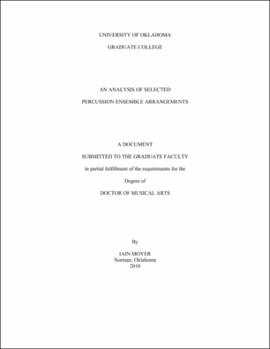| dc.contributor.advisor | Wakefield, William K||Drege, Lance | |
| dc.creator | Moyer, Iain | |
| dc.date.accessioned | 2019-06-03T20:36:17Z | |
| dc.date.available | 2019-06-03T20:36:17Z | |
| dc.date.issued | 2010 | |
| dc.identifier | 9986875702042 | |
| dc.identifier.uri | https://hdl.handle.net/11244/320243 | |
| dc.description.abstract | The emergence of the percussion ensemble in the early twentieth century and its continued expansion into the twenty-first has resulted in a substantial amount of new music for this relatively young musical genre. This unique collection of instruments has fostered not only original compositions, but also countless arrangements in a wide variety of styles. | |
| dc.description.abstract | This document will examine three exemplary percussion ensemble arrangements. These pieces will be analyzed to ascertain how the arranger constructed an effective percussive rendering of the original symphonic work. Furthermore, each of the percussion arrangers included in this study will be interviewed to understand what elements of the original symphonic material influenced the creation of their percussion ensemble arrangement. | |
| dc.description.abstract | The commonalities and differences between these three arrangements will be scrutinized in order to understand basic principles of effective percussion arranging. These principles will be synthesized into arranging guidelines that can be used by the next generation of percussion arrangers. Lastly, recommendations for further research on the subject of percussion arranging will be included. | |
| dc.format.extent | 207 pages | |
| dc.format.medium | application.pdf | |
| dc.language | en_US | |
| dc.relation.requires | Adobe Acrobat Reader | |
| dc.subject | Percussion ensembles--Analysis, appreciation | |
| dc.subject | Percussion ensembles--History and criticism | |
| dc.title | An Analysis of Selected Percussion Ensemble Arrangements | |
| dc.type | text | |
| dc.type | document | |
| dc.thesis.degree | D.M.A. | |
| ou.group | Weitzenhoffer Family College of Fine Arts::School of Music | |
